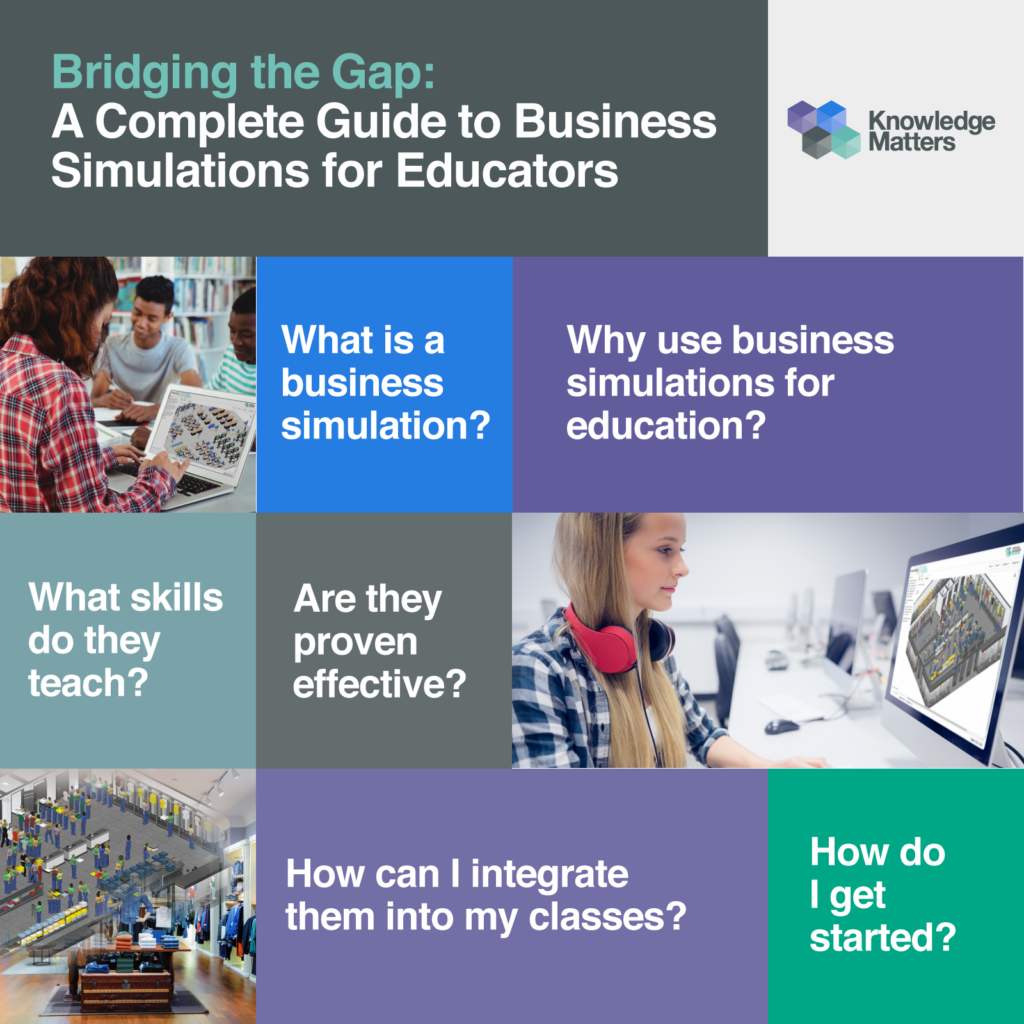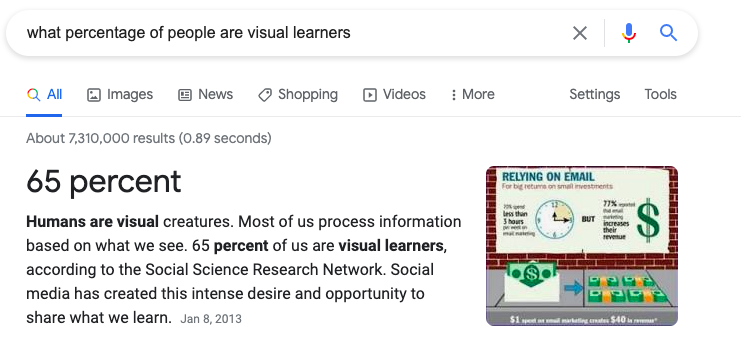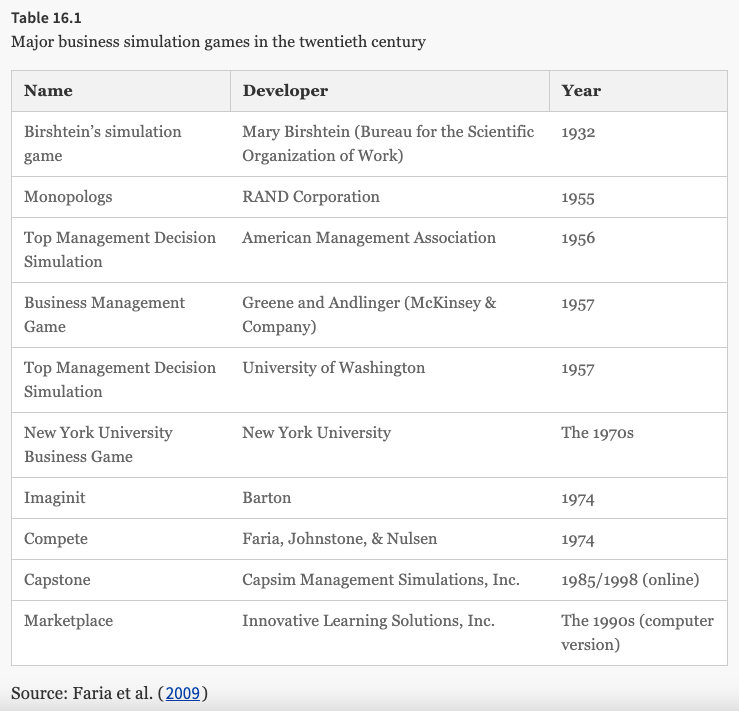The Ultimate Guide to Business Simulations for Educators

Click here for a printable PDF of this article to print and share with your students.
Why use business simulations for education?
When it comes to workplace skills, traditional education is falling behind the curve.
This is troubling for high school and college educators everywhere. According to LinkedIn’s 2021 Workplace Learning Report, 57% of learning and development (L&D) professionals are turning to digital learning to educate their employees on the job, while 37% of them are reducing instructor-led training.
On-the-job training is on the rise. Just look at the trend away from college education in technical fields. Workplaces and schools alike can use business simulations as a way to solve this problem.
Business simulations are a risk-free training field that allow students to develop crucial workplace skills in a controlled environment. They bridge the gap between theory and practice.
Explore business simulations for your classroom:
For high school students
For college students
What is a business simulation?
Business simulations are a form of “serious game,” designed with hands-on education as the primary goal.
The word “simulation” brings to mind popular entertainment games like The Sims 4 or SimCity. Business simulations aren’t designed purely for entertainment like these games, but they can be just as engaging.
Technically, a business simulation is anything that simulates a business environment. This can include board games, team-building role-play scenarios, or even choose-your-own adventure stories. That said, the most common — and most accessible — version of business simulations is the browser-based computer game.
A good business simulation breaks down a specific business-based environment such as restaurant management, entrepreneurship, or hospitality, and immerses students in that workspace.
Students must think critically and make crucial decisions fast. They then watch the consequences of their actions play out — for better or for worse.
What skills do business simulations teach?
Business simulations teach hard and soft skills tailored to their individual real-life counterparts. For example, your students may learn to start a business, manage a hotel, or conduct market research, among many other options.

Since hundreds of simulations exist, there are multiple ways of categorizing them and the skills they teach. In general, though, business simulations fall into three categories:
Executive Simulations
Students manage all aspects of their businesses as executives or CEOs.
Departmental Simulations
Students focus on mastering one segment of the business, like marketing or finance.
Concept Simulations
Students double down on a hyper-specific area, like sports management.
Different business simulations are tailored to address the challenges unique to each role. By choosing the right business simulation for your class, you can equip your students with skills to function in a real-life work environment.
Along with the hard skills that business simulations teach, students learn a variety of soft skills. These include:
- Critical thinking
- Decision-making under pressure
- Teamwork
- Communication skills
- Self-motivated learning
After your students work through a simulation, you can help them reflect on what they’ve learned to lodge the experience firmly in their minds. Post-graduation, your students can draw on these skills to enter the job market several strides ahead of the rest.
Are business simulations effective?
Business simulations improve students’ understanding of their chosen field, but how can educators be sure that this tool is actually useful in the workplace?
To answer that question, let’s take a look at other industries that use simulations:
Firefighters use simulations to ensure their safety while learning to navigate burning buildings and rescue missions.
Medical professionals practice on plastic models and cadavers before anyone lets them near a living patient.
U.S. soldiers run through grueling training exercises and war games to ensure their preparation for the field.
Having the chance to practice any skill in a simulated environment teaches field-specific skills in a way that truly sinks in. Students who have worked through business simulations enter the workforce with a firm understanding of what they are expected to do.
Additionally, academic studies show that after playing through simulation games, students improve their conceptual knowledge of their field, as well as their ability to work as a team.
To top it all off, business simulations have been in use for thousands of years — that is, if you count the original war game…chess.
A brief look at the past 100 years alone proves that business simulations have not only been around for ages, but also have tangible positive effects on the students who use them.
For example: try Googling “what percentage of people are visual learners?”
This is what you get:

65% of the population are visual learners. That’s 65% of your students at least who will benefit from hands-on learning activities like business simulations.
Plus, this means that simulations with rich visuals (as opposed to simulations that just display a series of numbers) create an impactful learning experience for all of the visual learners in your classroom.
It’s the difference between learning what a business is, and seeing one in action for yourself.
How long have business simulations been tested?
Business simulations have an extensive history which has long been left to the realm of academia and simulation-specific conventions. That’s a shame, because it can teach educators everywhere a great deal about the effects of learning through action.
Although it’s a bit dated, this study from the 2009 edition of Simulation Gaming provides an excellent in-depth look at the first 40 years of contemporary business simulation history. Here’s the run-down:
Discounting chess and other ancient war-strategy games, the first business simulation was invented in 1932 by Mary Birshtein.
As a high-ranking manager in the Bureau for the Scientific Organization of Work in Leningrad, Russia, Birshtein realized that strategic war games could be adapted to a business environment. Using those games as a model, she developed a simulation to simulate production and distribution processes at a typewriter factory.
By 1940, Birshtein and her team had developed 40 similar exercises. Across the sea, the USA-based RAND Corporation saw how effective Birshstein’s model was. In 1955, they created a U.S. Airforce logistics system called MONOPOLOGOS that taught participants how to best handle inventory management.
These original simulations were hand-scored, and although they had an undeniable impact on workplace productivity, their scope was limited. All student answers were handwritten and had to be reviewed one-by-one. It was easy for administrators to misread student handwriting (all teachers can relate), which led to errors in the final simulation.
All of this took time. To be able to adapt to a rapidly growing and changing economy, business simulations needed a way to score student answers accurately and quickly.
Then, mainframe computers entered the scene. Everything started to snowball.
In 1956, the American Management Association developed the first widely-known business game — TOP MANAGEMENT DECISION SIMULATION.
In 1957, Green and Andlinger developed BUSINESS MANAGEMENT GAME for the McKinsey & Company consulting firm.
1957 also saw the first-ever business simulation used in a university classroom — TOP MANAGEMENT DECISION GAME, developed for a business policy course at the University of Washington.
As soon as Mary Birshtein developed business simulations in 1932, business owners across the globe recognized their value.

Image Source: Pászto and Pánek
Mainframe computers got rid of messy student handwriting, and using a computer to read student answers meant that the simulation could be completed faster.
That said, it was still an awkward, clunky process, and it wasn’t accessible to many — that is, until the PC was invented in 1984. The Windows operating system showed up the very next year. Once again, everything changed. The growing popularity of PCs meant that more users could access these training simulations than ever before.
On a PC, it was much easier to install and administer games. Student answers were recorded on a disk, then uploaded to a server computer. This sped up the process of analyzing and responding to students’ choices.
Fortune Builder (1984) was one of the earliest simulations for PC (the graphics are truly a blast from the past).

Before the internet, though, PC-based simulations still suffered from the time and effort it took to first download data to local computers and then upload them to a separate server computer. Aside from simply taking hours, this manual process created security problems.
To succeed in the modern era, business simulations needed to be accessible from any point while securing user data and remaining easy to use. The Internet provided exactly that.
What are the advantages of browser-based business simulations?
Once the Internet became a household commodity, it opened up a whole new avenue of opportunities for business simulations. Participants in browser-based business simulations can work together with teammates from anywhere in the world.
Real-time browser-based simulations like Tycoon Systems’ IndustryMasters (2007) allowed players from anywhere to compete in real time for profits and market share.
Nowadays, nearly all business simulations are either browser-based or downloadable, which means they’re widely accessible to a diverse audience.
Online business simulations can be used for remote, hybrid, or in-class teaching, as students can easily access the interface from any device.
They work as a teaching tool by taking advantage of gamifying the learning process.
The scholarly definition of “gamifying” is “the use of game design elements in non-game contexts.” Normally, gamifying lessons means integrating rewards-based learning or adding competitive aspects to classroom exercises. Anything and everything can be gamified nowadays (including the stock market), which goes to show how effective of a learning method it is.
By going a step further and actually creating games that simulate business environments, students experience a new level of educational immersion that’s unique to business simulations.
How can I integrate business simulations into my classes?
There are multiple ways for educators to take advantage of business simulations. They can be used as in-class activities, homework assignments, or even capstone projects.
As business education expert Tim Rogmans has explained, business simulations are more than a quick fix to spice up your teaching methods…instead, they are in-depth, complex, dynamic settings that require focus and planning.
When deciding whether or not a business simulation is right for your class, consider the following:
- What are your learning objectives for this class?
- How much time are you able to devote to the simulation?
- Is it clear to the students how this exercise links to the course?
Despite the time it takes to set up a business simulation exercise, Rogmans notes that well-used business simulations can actually save time in the long run. By immersing students in a hands-on learning environment, business simulations cement real-life lessons in students’ minds and reduce the amount of time spent repeating questions.
Rogmans strongly recommends using business simulations in an online class environment. They mesh well with the self-directed nature of online learning, especially because business simulations are unique in their ability to equip students with real-world skills in a risk-free environment.
When compared with textbook learning, traditional workplace training, and even gamified teaching methods, business simulations stand out as a complex, instructive, and entertaining method of learning by doing.
From ancient days, people have used games to simulate strategic decisions. Now, technological advances allow business simulations to explore more complex situations, create more realistic scenarios, and reach even more people.
It’s a known problem that students are graduating high school and even college without the necessary skills to make it in the workforce. For educators looking to change this, business simulations are a tested way forward.
How do I get started?
Knowledge Matters offers a wide range of business simulations for high school and college, all for less than most textbooks.
Our Virtual Business (VB) High School simulations are browser-based, online business simulations that allow you to build an interactive curriculum for business, marketing, finance, and more.
For college students, our Case Simulations depart from traditional turn-based business simulations to provide a seamless game-like interface that reduces time spent learning the software and increases time spent learning the subject.
For more information, check out the links below:
Explore business simulations for your classroom:
For high school students
For college students